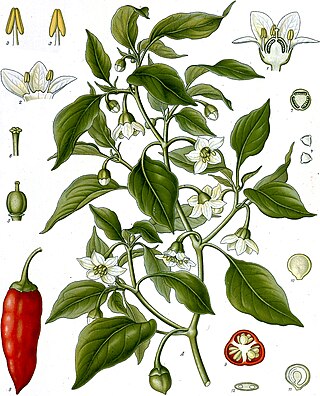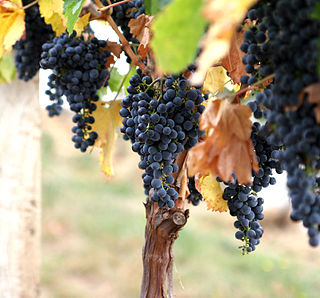
In botany, a fruit is the seed-bearing structure in flowering plants that is formed from the ovary after flowering.

A grape is a fruit, botanically a berry, of the deciduous woody vines of the flowering plant genus Vitis. Grapes are a non-climacteric type of fruit, generally occurring in clusters.

In botany, a seed is a plant embryo and food reserve enclosed in a protective outer covering called a seed coat (testa). More generally, the term "seed" means anything that can be sown, which may include seed and husk or tuber. Seeds are the product of the ripened ovule, after the embryo sac is fertilized by sperm from pollen, forming a zygote. The embryo within a seed develops from the zygote and grows within the mother plant to a certain size before growth is halted.

In botany and horticulture, parthenocarpy is the natural or artificially induced production of fruit without fertilisation of ovules, which makes the fruit seedless. The phenomenon has been observed since ancient times but was first scientifically described by German botanist Fritz Noll in 1902.

The endosperm is a tissue produced inside the seeds of most of the flowering plants following double fertilization. It is triploid in most species, which may be auxin-driven. It surrounds the embryo and provides nutrition in the form of starch, though it can also contain oils and protein. This can make endosperm a source of nutrition in animal diet. For example, wheat endosperm is ground into flour for bread, while barley endosperm is the main source of sugars for beer production. Other examples of endosperm that forms the bulk of the edible portion are coconut "meat" and coconut "water", and corn. Some plants, such as certain orchids, lack endosperm in their seeds.

Capsicum annuum, commonly known as paprika, chili pepper, red pepper, sweet pepper, jalapeño, cayenne, or bell pepper, is a fruiting plant from the family Solanaceae (nightshades), within the genus Capsicum which is native to the northern regions of South America and to southwestern North America. The plant produces berries of many colors including red, green, and yellow, often with pungent taste. It is also one of the oldest cultivated crops, with domestication dating back to around 6,000 years ago in regions of Mexico. The genus Capsicum has over 30 species but Capsicum annuum is the primary species in its genus, as it has been widely cultivated for human consumption for a substantial amount of time and has spread across the world. This species has many uses in culinary applications, medicine, self defense, and can even be ornamental.

Vitis rupestris is a species of grape native to the United States that is known by many common names including July, Coon, sand, sugar, beach, bush, currant, ingar, rock, and mountain grape. It is used for breeding several French-American hybrids as well as many root stocks.

Millerandage is a potential viticultural hazard in which grape bunches contain berries that differ greatly in size and, most importantly, maturity. Its most common cause is cold, rainy or otherwise bad weather during the flowering stage of the vines though other factors, such as boron deficiency or fanleaf degeneration, may also play a role.
A seedless fruit is a fruit developed to possess no mature seeds. Since eating seedless fruits is generally easier and more convenient, they are considered commercially valuable.

In viticulture, veraison is the onset of the ripening of the grapes. The official definition of veraison is "change of color of the grape berries". Veraison represents the transition from berry growth to berry ripening, and many changes in berry development occur at veraison.

Nucellar embryony is a form of seed reproduction that occurs in certain plant species, including many citrus varieties. Nucellar embryony is a type of apomixis, where eventually nucellar embryos from the nucellus tissue of the ovule are formed, independent of meiosis and sexual reproduction. During the development of seeds in plants that possess this genetic trait, the nucellus tissue which surrounds the megagametophyte can produce nucellar cells, also termed initial cells. These additional embryos (polyembryony) are genetically identical to the parent plant, rendering them as clones. By contrast, zygotic seedlings are sexually produced and inherit genetic material from both parents. Most angiosperms reproduce sexually through double fertilization. Different from nucellar embryony, double fertilization occurs via the syngamy of sperm and egg cells, producing a triploid endosperm and a diploid zygotic embryo. In nucellar embryony, embryos are formed asexually from the nucellus tissue. Zygotic and nucellar embryos can occur in the same seed (monoembryony), and a zygotic embryo can divide to produce multiple embryos. The nucellar embryonic initial cells form, divide, and expand. Once the zygotic embryo becomes dominant, the initial cells stop dividing and expanding. Following this stage, the zygotic embryo continues to develop and the initial cells continue to develop as well, forming nucellar embryos. The nucellar embryos generally end up outcompeting the zygotic embryo, rending the zygotic embryo dormant. The polyembryonic seed is then formed by the many adventitious embryos within the ovule. The nucellar embryos produced via apomixis inherit its mother's genetics, making them desirable for citrus propagation, research, and breeding.

Phomopsis cane and leaf spot occurs wherever grapes are grown. Phomopsis cane and leaf spot is more severe in grape-growing regions characterized by a humid temperate climate through the growing season. Crop losses up to 30% have been reported to be caused by Phomopsis cane and leaf spot.

Vitis (grapevine) is a genus of 81 accepted species of vining plants in the flowering plant family Vitaceae. The genus consists of species predominantly from the Northern Hemisphere. It is economically important as the source of grapes, both for direct consumption of the fruit and for fermentation to produce wine. The study and cultivation of grapevines is called viticulture.

The annual growth cycle of grapevines is the process that takes place in the vineyard each year, beginning with bud break in the spring and culminating in leaf fall in autumn followed by winter dormancy. From a winemaking perspective, each step in the process plays a vital role in the development of grapes with ideal characteristics for making wine. Viticulturalists and vineyard managers monitor the effect of climate, vine disease and pests in facilitating or impeding the vine's progression from bud break, flowering, fruit set, veraison, harvesting, leaf fall and dormancy – reacting if need be with the use of viticultural practices like canopy management, irrigation, vine training and the use of agrochemicals. The stages of the annual growth cycle usually become observable within the first year of a vine's life. The amount of time spent at each stage of the growth cycle depends on a number of factors – most notably the type of climate and the characteristics of the grape variety.
This glossary of viticultural terms list some of terms and definitions involved in growing grapes for use in winemaking.

The Pixie Grape is a new type of Vitis vinifera cultivar. The Pixie is a natural dwarf grapevine that is derived from the periclinal L1/L2 chimera Pinot Meunier. These dwarf grapevines tend to have short internodes and prefer to grow flowers instead of tendrils. They grow from 1 foot to 2 feet in height and produce clusters with a size on average of 4 inches. It is simple to cultivate in greenhouses and grows year round. Its purpose was to create an easy tool with which to conduct grapevine research. The grape was developed by grape rootstock breeder Dr. Peter Cousins of the USDA and David Tricoli of the Plant Transformation Facility, University of California Davis.

Thomcord is a seedless table grape variety and a hybrid of the popular Thompson Seedless or Sultanina grape and Concord grape. Thomcord was developed in 1983 by Californian grape breeders working for the Agricultural Research Service (ARS), an agency of the United States Department of Agriculture (USDA), as part of a test to better understand a new seedless grape breeding procedure.

Autumn Royal is a seedless table grape variety first produced in California, and released in 1996. Its parentage includes many types of grapes, including Black rose, Calmeria, Flame Seedless and Ribier.

International Fruit Genetics (IFG) is a private Bakersfield, California-based fruit breeding company that licenses patented breeds of fruit to growers worldwide. The largest breeder of table grapes has licensed one type of this fruit to Bakersfield-based grower Grapery, Cotton Candy.

Shine Muscat is a diploid table grape cultivar resulted from a cross of Akitsu-21 and 'Hakunan' made by National Institute of Fruit Tree Science (NIFTS) in Japan in 1988. It has large yellow-green berries, crisp flesh texture, muscat flavor, high soluble solids concentration and low acidity. Nomenclature registration number is "Grape Agriculture and Forestry No. 21"「ぶどう農林21号」.
























